Jingyi Yu
An Energy-Efficient Edge Coprocessor for Neural Rendering with Explicit Data Reuse Strategies
Oct 09, 2025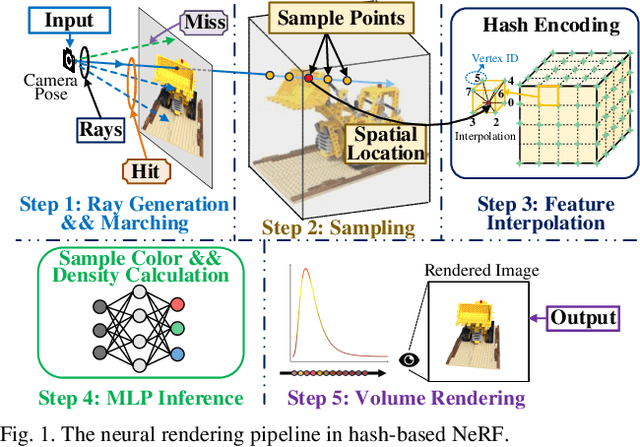
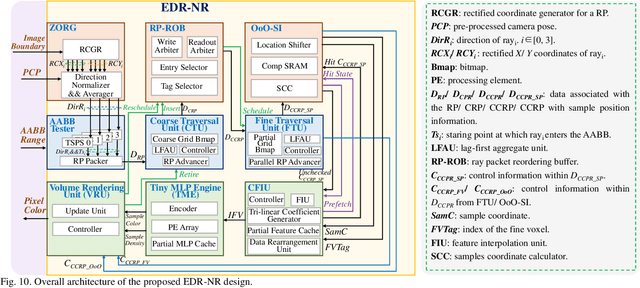
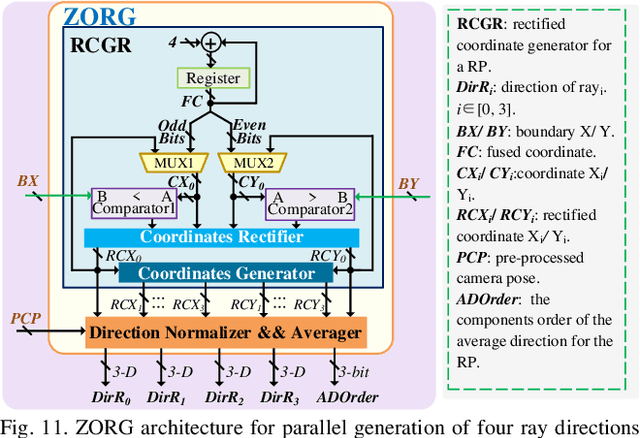
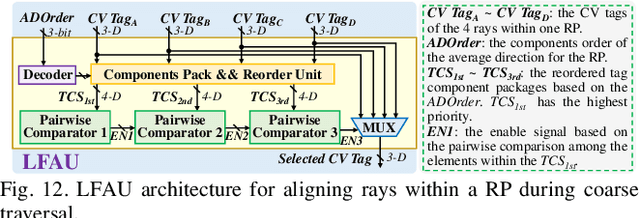
Abstract:Neural radiance fields (NeRF) have transformed 3D reconstruction and rendering, facilitating photorealistic image synthesis from sparse viewpoints. This work introduces an explicit data reuse neural rendering (EDR-NR) architecture, which reduces frequent external memory accesses (EMAs) and cache misses by exploiting the spatial locality from three phases, including rays, ray packets (RPs), and samples. The EDR-NR architecture features a four-stage scheduler that clusters rays on the basis of Z-order, prioritize lagging rays when ray divergence happens, reorders RPs based on spatial proximity, and issues samples out-of-orderly (OoO) according to the availability of on-chip feature data. In addition, a four-tier hierarchical RP marching (HRM) technique is integrated with an axis-aligned bounding box (AABB) to facilitate spatial skipping (SS), reducing redundant computations and improving throughput. Moreover, a balanced allocation strategy for feature storage is proposed to mitigate SRAM bank conflicts. Fabricated using a 40 nm process with a die area of 10.5 mmX, the EDR-NR chip demonstrates a 2.41X enhancement in normalized energy efficiency, a 1.21X improvement in normalized area efficiency, a 1.20X increase in normalized throughput, and a 53.42% reduction in on-chip SRAM consumption compared to state-of-the-art accelerators.
Causal Mechanism Estimation in Multi-Sensor Systems Across Multiple Domains
Jul 23, 2025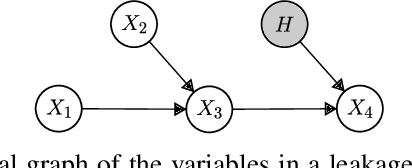
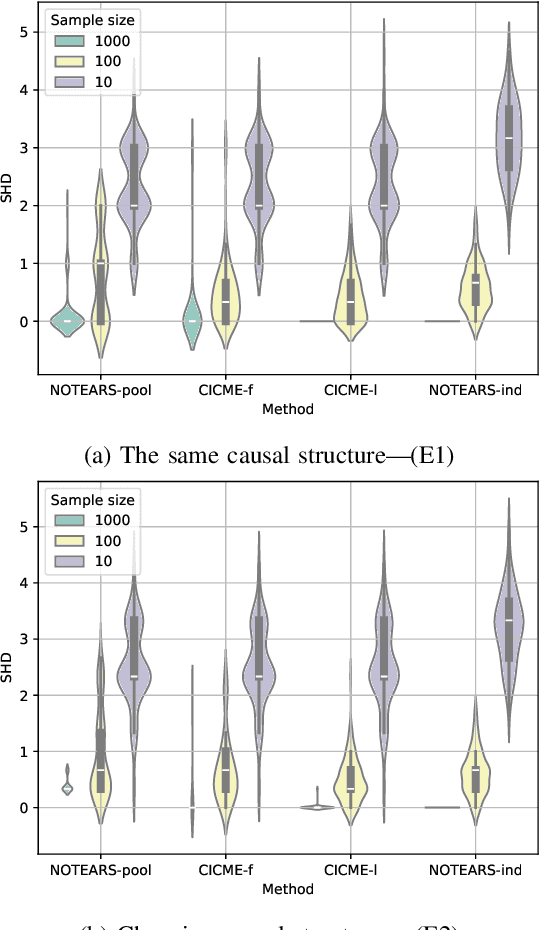
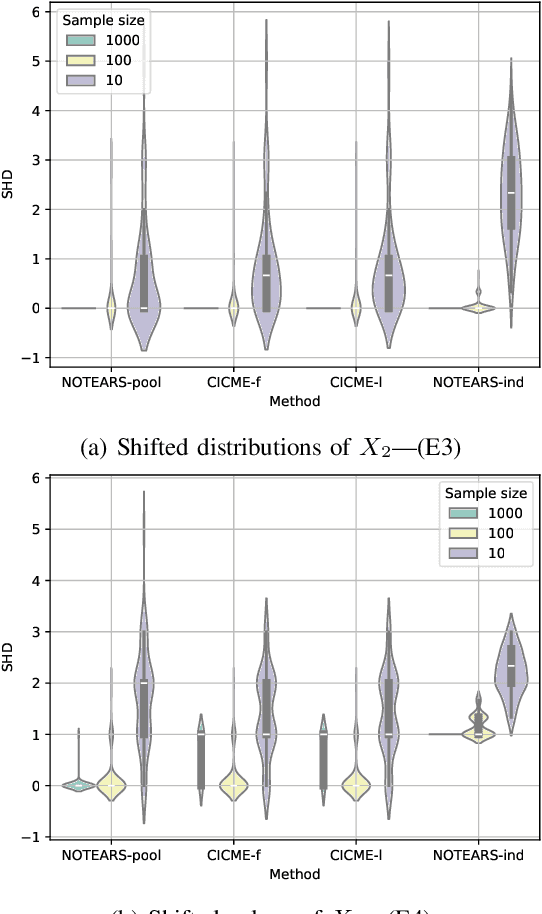
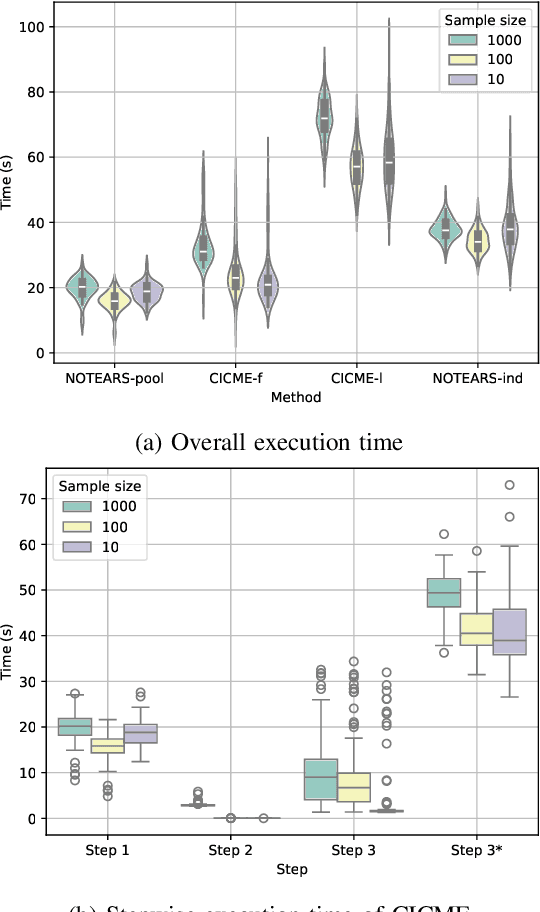
Abstract:To gain deeper insights into a complex sensor system through the lens of causality, we present common and individual causal mechanism estimation (CICME), a novel three-step approach to inferring causal mechanisms from heterogeneous data collected across multiple domains. By leveraging the principle of Causal Transfer Learning (CTL), CICME is able to reliably detect domain-invariant causal mechanisms when provided with sufficient samples. The identified common causal mechanisms are further used to guide the estimation of the remaining causal mechanisms in each domain individually. The performance of CICME is evaluated on linear Gaussian models under scenarios inspired from a manufacturing process. Building upon existing continuous optimization-based causal discovery methods, we show that CICME leverages the benefits of applying causal discovery on the pooled data and repeatedly on data from individual domains, and it even outperforms both baseline methods under certain scenarios.
MARMOT: Masked Autoencoder for Modeling Transient Imaging
Jun 10, 2025



Abstract:Pretrained models have demonstrated impressive success in many modalities such as language and vision. Recent works facilitate the pretraining paradigm in imaging research. Transients are a novel modality, which are captured for an object as photon counts versus arrival times using a precisely time-resolved sensor. In particular for non-line-of-sight (NLOS) scenarios, transients of hidden objects are measured beyond the sensor's direct line of sight. Using NLOS transients, the majority of previous works optimize volume density or surfaces to reconstruct the hidden objects and do not transfer priors learned from datasets. In this work, we present a masked autoencoder for modeling transient imaging, or MARMOT, to facilitate NLOS applications. Our MARMOT is a self-supervised model pretrianed on massive and diverse NLOS transient datasets. Using a Transformer-based encoder-decoder, MARMOT learns features from partially masked transients via a scanning pattern mask (SPM), where the unmasked subset is functionally equivalent to arbitrary sampling, and predicts full measurements. Pretrained on TransVerse-a synthesized transient dataset of 500K 3D models-MARMOT adapts to downstream imaging tasks using direct feature transfer or decoder finetuning. Comprehensive experiments are carried out in comparisons with state-of-the-art methods. Quantitative and qualitative results demonstrate the efficiency of our MARMOT.
CryoFastAR: Fast Cryo-EM Ab Initio Reconstruction Made Easy
Jun 06, 2025Abstract:Pose estimation from unordered images is fundamental for 3D reconstruction, robotics, and scientific imaging. Recent geometric foundation models, such as DUSt3R, enable end-to-end dense 3D reconstruction but remain underexplored in scientific imaging fields like cryo-electron microscopy (cryo-EM) for near-atomic protein reconstruction. In cryo-EM, pose estimation and 3D reconstruction from unordered particle images still depend on time-consuming iterative optimization, primarily due to challenges such as low signal-to-noise ratios (SNR) and distortions from the contrast transfer function (CTF). We introduce CryoFastAR, the first geometric foundation model that can directly predict poses from Cryo-EM noisy images for Fast ab initio Reconstruction. By integrating multi-view features and training on large-scale simulated cryo-EM data with realistic noise and CTF modulations, CryoFastAR enhances pose estimation accuracy and generalization. To enhance training stability, we propose a progressive training strategy that first allows the model to extract essential features under simpler conditions before gradually increasing difficulty to improve robustness. Experiments show that CryoFastAR achieves comparable quality while significantly accelerating inference over traditional iterative approaches on both synthetic and real datasets.
CityGo: Lightweight Urban Modeling and Rendering with Proxy Buildings and Residual Gaussians
May 28, 2025Abstract:Accurate and efficient modeling of large-scale urban scenes is critical for applications such as AR navigation, UAV based inspection, and smart city digital twins. While aerial imagery offers broad coverage and complements limitations of ground-based data, reconstructing city-scale environments from such views remains challenging due to occlusions, incomplete geometry, and high memory demands. Recent advances like 3D Gaussian Splatting (3DGS) improve scalability and visual quality but remain limited by dense primitive usage, long training times, and poor suit ability for edge devices. We propose CityGo, a hybrid framework that combines textured proxy geometry with residual and surrounding 3D Gaussians for lightweight, photorealistic rendering of urban scenes from aerial perspectives. Our approach first extracts compact building proxy meshes from MVS point clouds, then uses zero order SH Gaussians to generate occlusion-free textures via image-based rendering and back-projection. To capture high-frequency details, we introduce residual Gaussians placed based on proxy-photo discrepancies and guided by depth priors. Broader urban context is represented by surrounding Gaussians, with importance-aware downsampling applied to non-critical regions to reduce redundancy. A tailored optimization strategy jointly refines proxy textures and Gaussian parameters, enabling real-time rendering of complex urban scenes on mobile GPUs with significantly reduced training and memory requirements. Extensive experiments on real-world aerial datasets demonstrate that our hybrid representation significantly reduces training time, achieving on average 1.4x speedup, while delivering comparable visual fidelity to pure 3D Gaussian Splatting approaches. Furthermore, CityGo enables real-time rendering of large-scale urban scenes on mobile consumer GPUs, with substantially reduced memory usage and energy consumption.
One Policy but Many Worlds: A Scalable Unified Policy for Versatile Humanoid Locomotion
May 24, 2025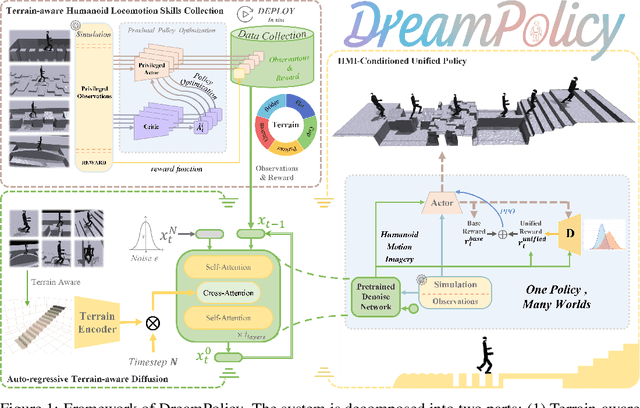

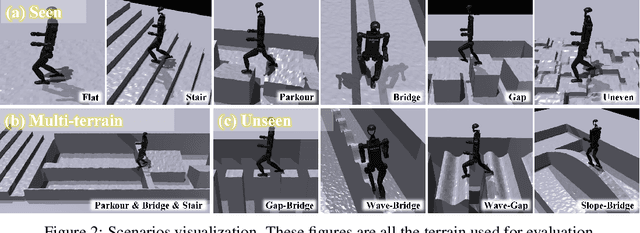

Abstract:Humanoid locomotion faces a critical scalability challenge: traditional reinforcement learning (RL) methods require task-specific rewards and struggle to leverage growing datasets, even as more training terrains are introduced. We propose DreamPolicy, a unified framework that enables a single policy to master diverse terrains and generalize zero-shot to unseen scenarios by systematically integrating offline data and diffusion-driven motion synthesis. At its core, DreamPolicy introduces Humanoid Motion Imagery (HMI) - future state predictions synthesized through an autoregressive terrain-aware diffusion planner curated by aggregating rollouts from specialized policies across various distinct terrains. Unlike human motion datasets requiring laborious retargeting, our data directly captures humanoid kinematics, enabling the diffusion planner to synthesize "dreamed" trajectories that encode terrain-specific physical constraints. These trajectories act as dynamic objectives for our HMI-conditioned policy, bypassing manual reward engineering and enabling cross-terrain generalization. DreamPolicy addresses the scalability limitations of prior methods: while traditional RL fails to exploit growing datasets, our framework scales seamlessly with more offline data. As the dataset expands, the diffusion prior learns richer locomotion skills, which the policy leverages to master new terrains without retraining. Experiments demonstrate that DreamPolicy achieves average 90% success rates in training environments and an average of 20% higher success on unseen terrains than the prevalent method. It also generalizes to perturbed and composite scenarios where prior approaches collapse. By unifying offline data, diffusion-based trajectory synthesis, and policy optimization, DreamPolicy overcomes the "one task, one policy" bottleneck, establishing a paradigm for scalable, data-driven humanoid control.
JSover: Joint Spectrum Estimation and Multi-Material Decomposition from Single-Energy CT Projections
May 12, 2025Abstract:Multi-material decomposition (MMD) enables quantitative reconstruction of tissue compositions in the human body, supporting a wide range of clinical applications. However, traditional MMD typically requires spectral CT scanners and pre-measured X-ray energy spectra, significantly limiting clinical applicability. To this end, various methods have been developed to perform MMD using conventional (i.e., single-energy, SE) CT systems, commonly referred to as SEMMD. Despite promising progress, most SEMMD methods follow a two-step image decomposition pipeline, which first reconstructs monochromatic CT images using algorithms such as FBP, and then performs decomposition on these images. The initial reconstruction step, however, neglects the energy-dependent attenuation of human tissues, introducing severe nonlinear beam hardening artifacts and noise into the subsequent decomposition. This paper proposes JSover, a fundamentally reformulated one-step SEMMD framework that jointly reconstructs multi-material compositions and estimates the energy spectrum directly from SECT projections. By explicitly incorporating physics-informed spectral priors into the SEMMD process, JSover accurately simulates a virtual spectral CT system from SE acquisitions, thereby improving the reliability and accuracy of decomposition. Furthermore, we introduce implicit neural representation (INR) as an unsupervised deep learning solver for representing the underlying material maps. The inductive bias of INR toward continuous image patterns constrains the solution space and further enhances estimation quality. Extensive experiments on both simulated and real CT datasets show that JSover outperforms state-of-the-art SEMMD methods in accuracy and computational efficiency.
ExFace: Expressive Facial Control for Humanoid Robots with Diffusion Transformers and Bootstrap Training
Apr 20, 2025



Abstract:This paper presents a novel Expressive Facial Control (ExFace) method based on Diffusion Transformers, which achieves precise mapping from human facial blendshapes to bionic robot motor control. By incorporating an innovative model bootstrap training strategy, our approach not only generates high-quality facial expressions but also significantly improves accuracy and smoothness. Experimental results demonstrate that the proposed method outperforms previous methods in terms of accuracy, frame per second (FPS), and response time. Furthermore, we develop the ExFace dataset driven by human facial data. ExFace shows excellent real-time performance and natural expression rendering in applications such as robot performances and human-robot interactions, offering a new solution for bionic robot interaction.
Dissecting and Mitigating Diffusion Bias via Mechanistic Interpretability
Mar 26, 2025Abstract:Diffusion models have demonstrated impressive capabilities in synthesizing diverse content. However, despite their high-quality outputs, these models often perpetuate social biases, including those related to gender and race. These biases can potentially contribute to harmful real-world consequences, reinforcing stereotypes and exacerbating inequalities in various social contexts. While existing research on diffusion bias mitigation has predominantly focused on guiding content generation, it often neglects the intrinsic mechanisms within diffusion models that causally drive biased outputs. In this paper, we investigate the internal processes of diffusion models, identifying specific decision-making mechanisms, termed bias features, embedded within the model architecture. By directly manipulating these features, our method precisely isolates and adjusts the elements responsible for bias generation, permitting granular control over the bias levels in the generated content. Through experiments on both unconditional and conditional diffusion models across various social bias attributes, we demonstrate our method's efficacy in managing generation distribution while preserving image quality. We also dissect the discovered model mechanism, revealing different intrinsic features controlling fine-grained aspects of generation, boosting further research on mechanistic interpretability of diffusion models.
Expert Race: A Flexible Routing Strategy for Scaling Diffusion Transformer with Mixture of Experts
Mar 20, 2025Abstract:Diffusion models have emerged as mainstream framework in visual generation. Building upon this success, the integration of Mixture of Experts (MoE) methods has shown promise in enhancing model scalability and performance. In this paper, we introduce Race-DiT, a novel MoE model for diffusion transformers with a flexible routing strategy, Expert Race. By allowing tokens and experts to compete together and select the top candidates, the model learns to dynamically assign experts to critical tokens. Additionally, we propose per-layer regularization to address challenges in shallow layer learning, and router similarity loss to prevent mode collapse, ensuring better expert utilization. Extensive experiments on ImageNet validate the effectiveness of our approach, showcasing significant performance gains while promising scaling properties.
 Add to Chrome
Add to Chrome Add to Firefox
Add to Firefox Add to Edge
Add to Edge